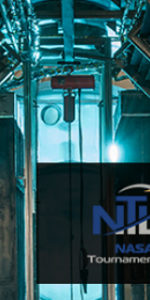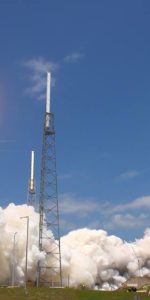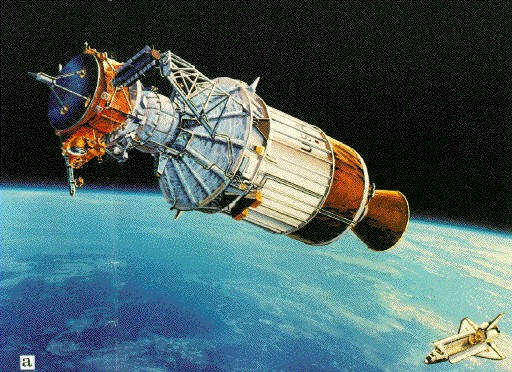
Dick Richards enjoyed a sound night’s sleep on 5 October 1990. In the astronaut crew quarters at the Kennedy Space Center (KSC) in Florida, he was only hours away from commanding his first shuttle mission—having previously served as Pilot on STS-28, a classified Department of Defense flight a year earlier, which had returned to Earth with a blob of hypersonic gunge on his window—and bring to an end a lengthy series of delays which impacted two of NASA’s fleet of three orbiters. Before bedding down for what he expected to be his final night on Earth, before launching on Discovery on STS-41, Richards had specifically asked to be awakened if any issues should arise. None did, and 6 October dawned fine over the marshy landscape. During the four days of STS-41, which took place 25 years ago, this week, Richards and his four crewmates successfully launched the shuttle’s fastest-ever Earth-departing payload: the joint U.S./European Ulysses spacecraft, bound for no fewer than three exploratory voyages over the Sun’s north and south poles.
As outlined in yesterday’s AmericaSpace history article, the heritage of Ulysses’ name—honoring a long and convoluted journey, with many twists and turns of fortune—was entirely fitting, for it met with significant delay and replanning between its creation in 1976 and its originally targeted launch date in May 1986. Subsequently delayed in the aftermath of the Challenger accident, Ulysses’ liquid-fueled Centaur-G Prime booster was canceled and by April 1987 it had been remanifested atop the combination of a solid-fueled Inertial Upper Stage (IUS) and a Payload Assist Module (PAM)-S. In September 1989, Richards was named to command the STS-41 Ulysses mission, joined by Pilot Bob Cabana and Mission Specialists Bruce Melnick, Bill Shepherd, and Tom Akers. In time, his crewmates would carve their own niches into the annals of spaceflight history: Cabana went on to head the Astronaut Office, command the first International Space Station (ISS) assembly mission, and is today’s Director of KSC, whilst Melnick was the first U.S. Coast Guard officer to fly into space, Shepherd later led the first long-duration ISS crew, and Akers participated in the first critical servicing of the iconic Hubble Space Telescope (HST).
Targeted for launch during an 18-day “window” which extended from 5-23 October 1990, the astronauts of STS-41 became the first shuttle crew to have all flown their first missions in the aftermath of Challenger; Richards having piloted STS-28 in August 1989, Shepherd having served aboard STS-27 in December 1988 and Cabana, Melnick, and Akers embarking on their first flights. For Richards, such an early rotation into a shuttle command was a “plum” assignment, after waiting more than nine years for his first launch. In his debriefing after STS-28, he wryly described himself as “the plank-holder,” for having endured the longest wait of his 1980 class for a mission. “I guess management felt like they owed it to me to make it up to me,” Richards told the NASA oral historian, “and so they had turned me around and got me ready for my first command on STS-41, right away.”
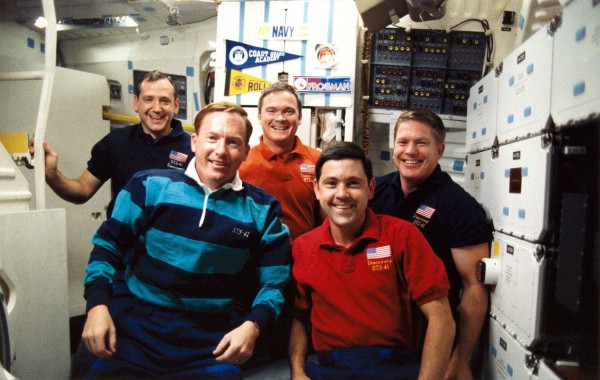
Richards saw it as his duty to ensure that his crew was ready; “I had the luxury of nine years getting ready to go fly,” he said, but “they didn’t have that much time.” To make them as confident with the shuttle as possible, he decided to put together a crash course in systems knowledge—they ended up giving each other weekly lectures from their perspective—and although Richards admitted that the move was both popular and unpopular, the end fulfilled the means. “I spent a lot of time worrying about their systems knowledge,” he said, “and ship basics, because of the lack of their shelf life. By the time we got done on that crew, we knew the vehicle backwards and forwards.” It helped, of course, that all five men were incredibly smart, focused, and self-motivated, and that all were active military personnel. They knew the chain of command, they understood the importance of duty and single-minded devotion to accomplishing the mission, and performed admirably.
However, Discovery’s sister shuttles, Columbia and Atlantis, endured months of delays throughout the summer and fall of 1990, due to maddening series of hydrogen leaks, which required multiple repairs, repeated rollouts to the launch pad, and rollbacks from the launch pad and ultimately the creation of a dedicated “tiger team” to resolve the problems. Fortunately, Discovery—which had previously deployed HST during her STS-31 mission in late April 1990—was largely unaffected by the woes of her sisters. Following her return from STS-31, she was transported by the Boeing 747 Shuttle Carrier Aircraft (SCA) from her landing site at Edwards Air Force Base, Calif., back to her Florida home, and ensconced in the Orbiter Processing Facility (OPF) on 8 May to begin STS-41 processing. It could hardly have been anticipated at this point that no more shuttles would fly for almost six months and that it would be Discovery which would finally return to fleet to operations.
Rolled over to the Vehicle Assembly Building (VAB) on 27 August for stacking onto her External Tank (ET) and twin Solid Rocket Boosters (SRBs), and from thence to Pad 39B on 4 September, Discovery had enjoyed an almost unblemished processing flow. In the pre-dawn darkness of 6 October, Richards led his men out of the Operations & Checkout (O&C) Building, bound for the pad. “We were pretty happy at this point,” he recalled at the post-mission press conference, “because no flight crew had made it this far, at least being able to walk out to the Astrovan in about six months, so we felt pretty good.” Although the fleet was steadily getting back onto its feet, the lengthy hydrogen leaks had eliminated NASA’s hopes of staging as many as nine shuttle missions in 1990. As circumstances transpired, by December, the agency managed to launch six flights. At Pad 39B, as they boarded the vehicle, a “Go ’87” sign hung over the side hatch paid tribute to the fact that Melnick and Akers would jointly become the first members of NASA’s 1987 class of astronaut selectees to fly into space.
Launched at 7:47:15 a.m. EDT, about 12 minutes into the 2.5-hour “window,” due to minor weather concerns and cloudy conditions at the Cape, the mission marked Discovery’s heaviest to date, with a total weight of 259,593 pounds (117,749 kg). “From a first-timer flier’s point of view, it was even more spectacular from the inside,” recalled Cabana after the mission. “It was an extremely smooth ride uphill, especially after we got off the solid rocket motors; it really surprised me how smooth the ride was.” Reaching orbit, fellow astronaut Ken Bowersox—seated at the Capcom’s console in the Mission Control Center (MCC) at the Johnson Space Center (JSC) in Houston, Texas—gave them a Go to open the shuttle’s payload bay doors, followed by a Go for orbital operations.
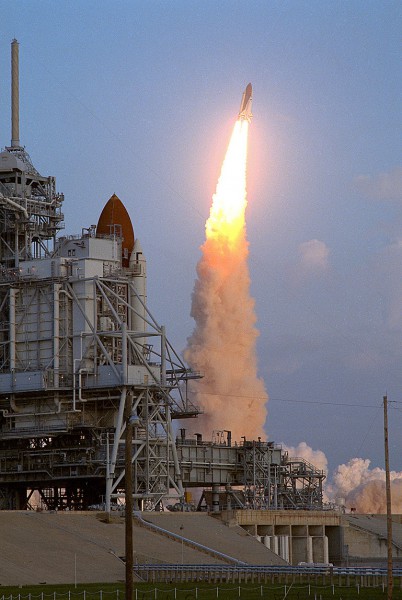
In the hours which followed, Akers and Melnick worked to prepare Ulysses and its combined IUS/PAM-S booster system for deployment. This event was slated to occur at six hours and one minute after launch. Watching Akers’ work, Dick Richards could not hide his admiration. “There was a time-critical bunch of steps,” he recalled, none more so that the purging of coolant from Ulysses’ plutonium-powered Radioisotope Thermoelectric Generator (RTG). “Tom had to get down on this switch panel, which was, for some reason, located in this obscure corner of the flight deck.”
Step by critical step, the instant of deployment drew closer: forward payload restraints were released, the aft frame of the IUS’ support structure tilted the stack to an angle of 29 degrees, Richards and Cabana maneuvered to the correct attitude, and electrical power was switched from the orbiter to the IUS. Finally, the three-minute purge of RTG coolant occurred, minutes before deployment. As Akers worked, his crewmates anxiously eyed the clock, keenly aware that a few minutes hence Ulysses would have to be gone. It brought back memories from a couple of their pre-flight simulations, in which Akers had been momentarily late with switch throws, but Richards trusted him implicitly to complete the job and for a few minutes left him alone. At length, however, the anxiety was pressing.
“Tom?” he asked. “How you doing?”
Akers looked up from his work and gave a broad grin. “Never had so much time!”
The tension in Discovery’s cabin was thus broken and, about a second earlier than intended—at six hours and 59 seconds Mission Elapsed Time (MET), in what the NASA Public Affairs Officer (PAO) described as “pretty good pointin’”—the ordnance to separate the IUS umbilical cables was activated and the stack was tilted to its deployment position of 58 degrees above the payload bay. Seemingly in slow motion, the spacecraft drifted smoothly and serenely away.
“Good deploy, Houston,” came the call from Discovery. “Ulysses is on its way.”
“That’s a great job!” replied Capcom Kathy Thornton.
The release itself occurred during orbital darkness, but as the shuttle approached sunrise, the sight of the Ulysses/IUS/PAM-S combo was, in Akers’ words, “a spectacular view.” Nineteen minutes later, Richards fired Discovery’s thrusters in a so-called “minus-X,” or “back-off,” maneuver, providing a separation rate of some 2.5 feet (76 cm) per second from the payload. That was followed, about 45 minutes after deployment, by the firing of the IUS’ first-stage engine, which was unseen by the astronauts, since Discovery had been reoriented with her belly facing Ulysses, thereby protecting her flight deck windows. After burning for 150 seconds, the first stage was jettisoned and the second stage fired for two minutes, then separated. Next up was McDonnell Douglas’ PAM-S, which initially “spun-up” Ulysses to 70 revolutions per minute for stability, then executed an 88-second burn to provide the final velocity increment and set the spacecraft on course for a 16-month cruise to Jupiter. Following the PAM-S burnout, Ulysses was “yo-yo-despun”—with weights deployed at the end of cables—to less than eight revolutions per minute. Departing Earth’s gravitational “well” at 34,510 mph (55,538 km/h), the spacecraft became the fastest human-made machine to depart the Home Planet. It was a record that would remain unbroken until NASA’s New Horizons left Earth at an estimated 37,000 mph (59,000 km/h) in January 2006.
For the astronauts, their involvement with Ulysses was now effectively at an end and responsibility passed to an army of flight controllers and trajectory specialists who would guide it toward a rendezvous with the Solar System’s largest planet in February 1992 and, later, for its exploration of the Sun. Although the role of the STS-41 crew had been exclusively to launch Ulysses, they had undertaken several trips to Europe, and particularly Holland and Germany, where much of the contracting and project management was undertaken. On one occasion, Richards recalled, it gave him a slightly unsettling introduction to European culture. At the end of each afternoon, the Germans would reach the end of their day, open up their cooler and pull out several kegs of beer. “We’d all sit around there, next to Ulysses,” he recalled, “toasting Ulysses and having beer. We didn’t do that here in the United States, so that was different. I kinda liked it.”

The remainder of the four-day mission was spent focusing upon middeck and payload bay experiments. Melnick and Akers went shirtless for a period, conducting the Blood Pressure Variability During Spaceflight investigation, part of Detailed Supplementary Objective (DSO)-602. As their televised bare torsos were wired-up with electrodes, they jokingly announced that “We decided to run this for all the ladies down there in Mission Control,” to which Capcom Kathy Thornton replied “We are waiting, breathlessly!” Additional experiments focused upon solar science, evaluations of materials in anticipation of the proposed retrieval of the Intelsat-603 communications satellite and solid-surface combustion studies. The crew also extended birthday greetings to Akers’ wife, Kaye, singing to her and producing a small cake, topped with a green-glowing “Kim light” stick, in lieu of a candle.
After just 98 hours, Discovery completed her third-shortest flight of all time—eclipsed only by STS-26 and Mission 51C—with a smooth touchdown at Edwards Air Force Base, Calif., at 6:57:18 a.m. PDT (9:57:18 a.m. EDT) on 10 October 1990. Backlit by a beautiful desert dawn, the shuttle swept across the mountains and alighted on Runway 22, rolling to a halt after just 49 seconds. For Dick Richards, it was too short a mission and he felt that the shuttle’s capabilities should have been monopolized by more time in orbit and more experiments. It was a point that he made during his post-mission debriefing and, as circumstances transpired, he went on to command the first Extended Duration Orbiter (EDO) mission in the summer of 1992. By that time, Ulysses herself had picked up an immense gravitational push from Jupiter and, over the following decade and a half, would complete no fewer than three passages over the Sun’s north and south poles. In so doing, the tiny spacecraft would reveal more about our parent star than had previously been acquired throughout human history.
This is part of a series of history articles, which will appear each weekend, barring any major news stories. Next week’s article will focus on the 20th anniversary of STS-73, an October 1995 mission which pioneered the kind of research performed today on the International Space Station (ISS)…and proved that science is “not for geeks”.
Want to keep up-to-date with all things space? Be sure to “Like” AmericaSpace on Facebook and follow us on Twitter: @AmericaSpace




